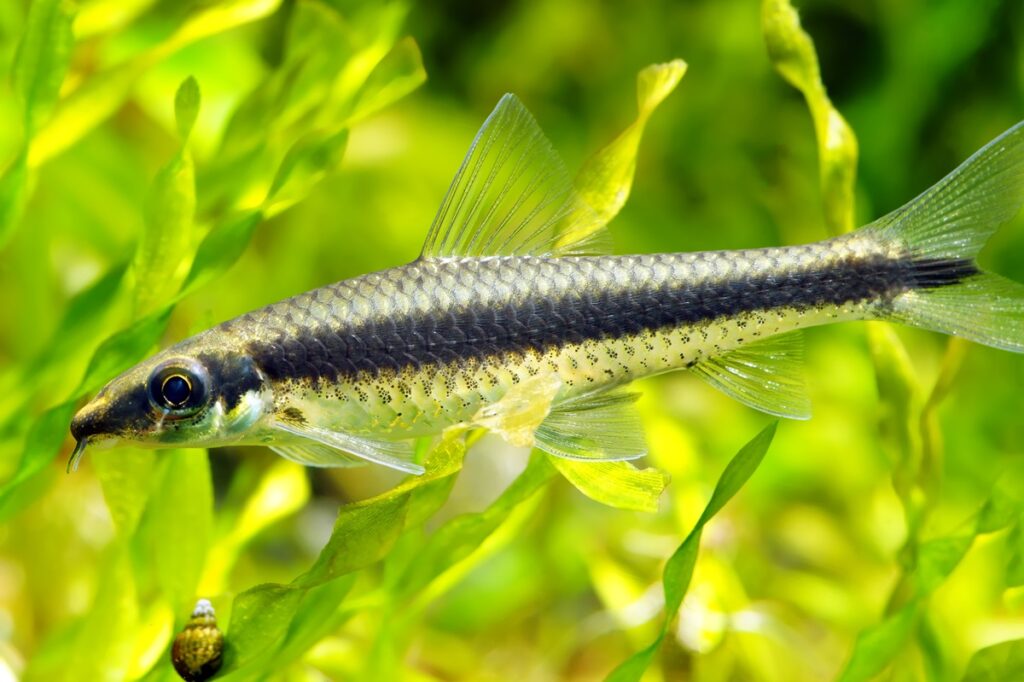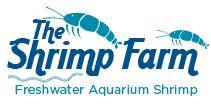True Siamese Algae Eater | Care & Info
Dealing with an algae problem in your aquarium? You're not alone! This is one of the most common issues aquarists run into with their tanks. You may have read about a "magical" fish that eats even the most pesky types of algae, keeping your tank looking clean: the Siamese algae eater (Crossocheilus oblongus).
Is this fish all it's made out to be? Does it really eat algae? How do you recognize and care for it? In this full Siamese algae eater care guide, The Shrimp Farm answers all those questions and more.
| Scientific name | Crossocheilus oblongus |
| Common names | Siamese algae eater, true Siamese algae eater, SAE, Siamese flying fox |
| Difficulty level | Intermediate |
| Origin | Southeast Asia |
Table of Contents
Siamese algae eater appearance & natural habitat
Appearance
The Siamese algae eater is a sleek-looking fish with an elongated, slender body. The base color is brownish to greyish, with a lighter belly and a dark stripe running all the way from the snout to the tail. These fish can grow to up to 6" in length. They sport small barbels on their lips, which they use to scour the bottom for food.
There has always been a bit of confusion when it comes to identifying this species, as there are a few aquarium fish out there that look quite similar.
Fishes that are commonly mistaken for the Siamese algae eater include:
- Gyrinocheilus aymonieri: The Chinese algae eater, though also often mistakenly called "Siamese". You can tell it apart by its sucker mouth.
- Epalzeorhynchos kalopterus: The flying fox, a name that's confusing because today's subject is sometimes called "Siamese flying fox". You can tell it apart by its yellowish body stripe.
- Garra cambodgiensis: Often called the "false Siamese algae eater" because they really do look quite similar. Also told apart by its yellow body stripe.
There's also actually a Crossocheilus species known as C. siamensis, but that one is rarely seen in the aquarium trade. The Siamese algae eaters you can buy are thought to usually be Crossocheilus oblongus, although sometimes a C. langei or C. atrilimes will slip through. Luckily, in terms of care and algae eating capacity, it doesn't really seem to matter which one you get.
Did you know? The Siamese algae eater is the type species of its genus, Crossocheilus: the species on which a genus is based. It was first scientifically described in 1823.
Natural habitat
The Siamese algae eater is naturally found in Southeast Asia. As its name suggests, it occurs in Thailand (formerly Siam), although it also pops up in Malaysia, Cambodia, and Laos, as well as the Indonesian islands of Sumatra and Borneo.
In its natural habitat, this fish can be found in fast-flowing streams and rivers. Being a bottom feeder, it usually stays in the lower water layer.
The IUCN Red List considers Crossocheilus oblongus to be a species of Least Concern. It does note that habitat loss as a result of logging and palm oil plantations can be a threat.
Setting up a Siamese algae eater aquarium
Requirements
Thinking of adding a few Siamese algae eaters to your tank? Good choice, but remember their size and activity level. They're not suitable for small aquariums; a tank of 55 gallons (long) or up will be necessary to house a small group.
Although this species will do well in most types of set-ups, the ideal would be to imitate its natural river habitat. Try going for a sandy substrate with river rocks, some driftwood, and sturdy plants like Java fern or Anubias. You can set the filter flow to high or add a small powerhead to create the flow level your Siamese algae eaters are used to.
Water parameters
Fish that naturally inhabit fast-flowing rivers that continually receive fresh, clean and oxygenated water don't respond well to low water quality in the aquarium. The Siamese algae eater is no exception. It should only be introduced to fully cycled and mature tanks.
Keep up with weekly water changes to ensure the tank stays clean. Regularly check the water quality using a liquid test kit to verify that everything is still in order.
pH: 6-7.5
Temperature: 70-79 °F
TDS: 50-250
Tankmates
Although Siamese algae eaters are sometimes marketed as fine to keep solo, they do occur in groups in the wild (safety in numbers, and all that!). If you keep one alone, it may become skittish. A group of at least five fish should work well to make sure they feel safe and disperse any internal bickering.
This is a peaceful species, although it is quite active, so it's best not to keep it with timid fish that appreciate their peace and quiet. The ideal tankmates would be species that hail from similar waters:
- Gastromyzon or Sewellia loaches
- Zebra danios
- Scissortail or Kubotai rasboras
- Garra, clown (need an XL aquarium!) or kuhli loaches
If you don't care about a species' origins, South American Corydoras catfish can also work well, as will barbs like rosy barbs or even good ol' neon tetras.
As for invertebrates, you should avoid small shrimp like Neocaridina. However, larger species like Amanos should be fine, as will dwarf crayfish. For a really cool option, you could try Atyopsis fan shrimp, which appreciate a higher flow level just like the Siamese algae eater does.
Siamese algae eater diet
As we've briefly mentioned, wild Siamese algae eaters are bottom feeders. They scour the river floor for detritus, microalgae, phytoplankton, and aufwuchs: basically any small, edible bits they can find.
So, what about in the aquarium? Are they really as good at eating algae as they're made out to be? Well, let us start with a disclaimer: YOU'RE the aquarium janitor. No fish or invertebrate can take over that role for you. Buying a fish because you hope it'll leave your tank sparkly clean will just lead to disappointment.
This being said, yes, Siamese algae eaters do live up to their name. Although you'll still have to perform regular aquarium maintenance, they can help in keeping pesky algae like hair algae under control. Some will even nibble on black beard algae, an annoying type that barely any other fish will go for.
Because the average home aquarium is too clean to sustain a group of Siamese algae eaters, you'll have to supplement their diet. Avoid protein-rich foods; daily meals of commercial herbivore food, algae tabs, spirulina, blanched leafy greens and the like are much better. You can even place smooth rocks in a bucket of water with a strong light pointed at them to grow your own algae!
Tip: Want some help keeping algae under control but can't fit a group of Siamese algae eaters in your tank? Shrimp are here to help. Have a look at our top 3 of algae-eating shrimp!
Breeding Siamese algae eaters
It's not common for Siamese algae eaters to breed in the home aquarium. Although some say it has happened, we aren't able to find any breeding reports.
This doesn't necessarily mean the SAEs for sale in your local aquarium store are live-caught. Large-scale fish farms have access to tools we don't, including gonadotropic hormones that induce spawning, making them able to produce captive-bred specimens.
Buying Siamese algae eaters
The Siamese algae eater is a relatively popular aquarium fish, so you should be able to find it for sale or have it ordered in for you at most aquarium stores. Just make sure you're getting the right fish, because as discussed in the section on appearance, there are a few similar species that can cause confusion.
You can also order your fish online. The Shrimp Farm sells Siamese algae eaters and ships them right to your doorstep with live arrival guarantee!
Sources & further reading
Ciccotto, P. J., Pfeiffer, J. M., & Page, L. M. (2017). Revision of the cyprinid genus Crossocheilus (Tribe Labeonini) with description of a new species. Copeia, 105(2), 269-292.
Rainboth, W. J. (1996). Fishes of the cambodian mekong. Food & Agriculture Org..



 Shrimp
Shrimp Fish
Fish Crab &
Crab & Plants
Plants Foods
Foods Snails
Snails
